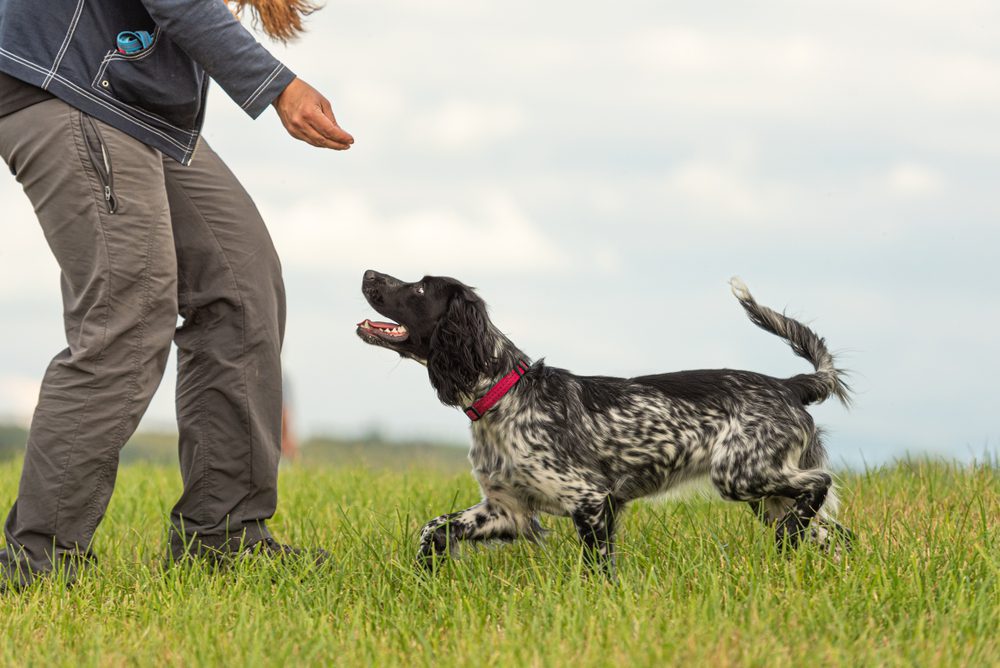Share This Article
If you’ve recently brought home a puppy or rescued a dog from a shelter, then you’re likely ready to work on basic obedience training. One of the most important skills you can teach your dog is to come when called.
This skill is crucial as it can be life-saving. For example, if your dog were to escape the house, your chances of getting them back will be much higher if the dog has a strong “come” recall (meaning they obey most of the time).
Similarly, if your dog is about to chase something into a busy street, you may be able to stop them by calling them to come. If you practice this skill enough, you can certainly get it to the level of mastery needed for it to be life-saving.
Now that we understand just how important this skill is let’s get right into training it. We’ll be providing step-by-step instructions on how to teach the basic skill as well as how to teach your dog to come even in the presence of distractions. Finally, we’ll share some tips and go over common mistakes so that you’ll be set for success.
Teaching the Come Cue

Whether you have a wee little pup or a rescue dog who never got a lot of training, your first step will be to teach them what come means. Your dog will learn that “come” means “run over to me.”
We will be using the word “yes” to mark that the dog is performing the correct action. However, you can use other words in place of “yes,” such as “good.” You can also use a clicker in place of a verbal marker.
1) Use Treats
Find an area in your house where there are minimal distractions for your puppy. Make sure your dog knows you have yummy treats. Give your puppy a taste of the reward to get them excited about the training session and to let them know that good things come from you.
2) Add Distance
Now, start walking away from your dog. If they follow you, say “yes” and reward them. Then, place a treat on the floor and try to get some distance between you and your dog (a few paces is enough) before they finish eating it.
Your dog will likely finish the treat and begin running toward you for more. As your dog starts running to you, say “yes;” when they get to you, grab their collar and reward them when they reach you by putting the treat on the floor again so that you can repeat this step.
You want to grab the collar to teach your dog that it isn’t an aversive action. In the future, should your dog ever get loose, they’ll be more likely to let you grab their collar should you manage to call them to you.
3) Add the Cue
Once your pup is reliably coming to you after eating their treat, it’s time to add the cue. After your dog has finished eating their treat and is running to you, say, “come.” Repeat this step a handful of times until your dog understands the cue.
Once your dog understands the cue, you’ll want to keep practicing “come” in situations with minimal distractions until your dog has a reliable recall.
How to Teach “Come” Around Distractions
Once you have taught your dog to come reliably in an environment with minimal distractions, you’ll want to start adding those distractions back in. You should start slowly with this to ensure success. The first distractions you use shouldn’t be all that distracting; you’ll work your way up to using items or treats that are highly distracting.
1) Practice Without Distractions
Practice the come recall without any distractions. This works as a good warm-up to the training as well as a reminder to your dog that performing the “come” skill is rewarding.
2) Add a Small Distraction
Place your distraction nearby where the dog can see it. The distraction could be a toy or some treats. If you use a toy, don’t use one of your dog’s favorites. Try to pick something they don’t play with often.
If you use treats, make sure they are not as good as whatever you are using as a reward. For instance, kibble is usually not as exciting as chicken since dogs eat kibble daily.
Make sure your dog is on a leash so that you can prevent them from obtaining whatever item you use as a distraction. You wouldn’t want to inadvertently reward them for not listening to you!
3) Repeat
Call your dog to you. The moment they look away from the distraction, and at you, you should say “yes” to mark that they’ve done something good. Say “yes” again when they are running toward you. Reward your dog while holding their collar when they reach you.
Continue practicing this step until your dog reliably comes away from the distraction or even begins to ignore it in favor of you. At this point, you can try repeating the exercise with increased difficulty by using a more exciting distraction.
If you’re having trouble getting your dog’s attention away from the distraction, then you can either move the distraction further away or try using something less enticing.
Tips for Success

Now that you know how to teach come, we’d like to share some tips that will set you up for success. These tips will help you avoid common mistakes as well as increase the likelihood of your dog listening to you.
Use a High-Value Reward
Dog trainers often talk about “high-value” currencies. What they mean by this is using a treat or a toy that is immensely rewarding for your dog.
These types of rewards are far more motivating to your dog than something like kibble, which dogs eat every day and thus is often not that exciting. When you have a strong motivator for your dog, it makes them more likely to obey.
A high-value reward will also create a positive connection in the dog’s brain. They learn that performing the behavior you ask of them is fun and has good consequences. Establishing this connection will make the dog more likely to listen to you in the future.
Don’t Punish Your Dog for Obeying
You may be thinking, “What? Why would I punish my dog if she comes when called?” However, it’s more common than you may think, and many people aren’t even doing it on purpose.
Of course, there are some people who will punish their dogs if they don’t come immediately. This is a bad idea because once the dog does come, they won’t know that they’re being punished for being slow. They will think they are being punished for obeying and will be less likely to do so in the future.
As far as inadvertently punishing “come” goes, many people will call their dog away from fun activities. Similarly, people may call their dog and then do things like give them a bath or trim their nails.
In these instances, the dog has been punished for coming when called (assuming the dog dislikes bath time and nail trims). Make sure that obeying is always fun and rewarding for your dog.
Be Consistent
Consistency is incredibly important in dog training because the opposite will only confuse your dog. When training “come,” you need to be consistent in what you expect of your dog. Some people make the mistake of using the word “come” when they actually mean something else, like “come closer” rather than “come to me.”
For instance, if you’re out on a hike with your dog off-leash and your dog is getting a little further than you might like, you might say “come.” The problem occurs when you allow your dog to run near you or past you but not directly to you.
You should not reward a dog if they do not actually come to you, and if they don’t, you should do your best to coax them over with claps, encouraging noises, or getting low to the ground. Do not use the word “come” unless you mean for your dog to come directly to you.
Another aspect of consistency is being consistent with your cues. You should strive to say “come” just once. If your dog doesn’t listen, try to get their attention by using their name, clapping, or whistling. You may have to go to your dog and lure them to you (but be careful not to turn things into a game of chase).
Saying “come” multiple times may confuse your dog. People who mistakenly repeat cues sometimes end up with dogs who will listen, but only after they hear the word three times. You wouldn’t want that!
Safety
It’s important to remember that while a come cue is great for safety, especially around cars, it can be dangerous when you’re on the opposite side of the street from your dog and a car is oncoming. For safety, an equally vital command to practice is to “lie down,” especially from far away distances.
Teaching a dog to lie down and stay until you’re closer or until called helps drivers know they won’t bolt into traffic and gives you extra time to get to your dog.
Practice Makes Perfect
One of the most important and useful skills you can teach your dog is to come when called. In fact, it can even be a life-saving skill that can prevent your dog from running into danger.
“Come” is straightforward to teach, but it takes a lot of repetition and practice (especially around distractions) before your dog will come every single time you call, no matter what’s happening around them. Luckily, using reward-based training makes learning a lot of fun for your dog.
Make sure to use high-value rewards, be consistent with your training, and avoid unintentionally punishing your dog for coming to you. Along with regular practice, these tips will set you and your pooch up for success.
